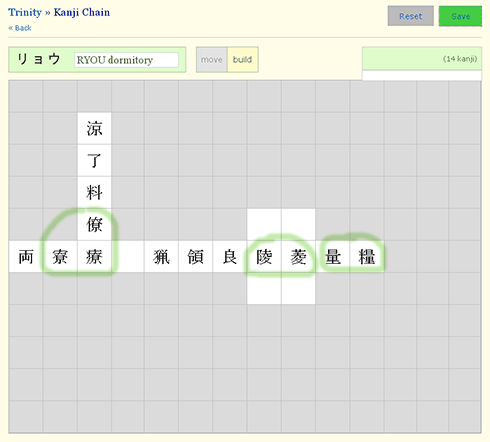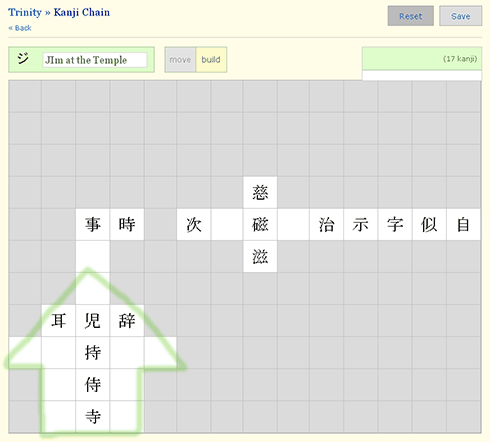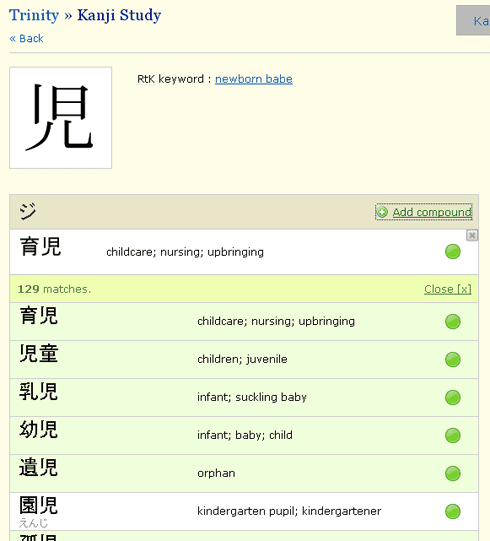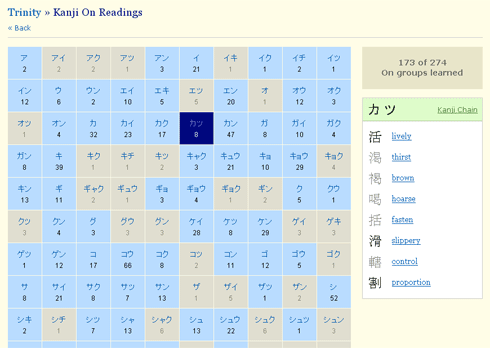-
26 December 2007Kanji chains, memory palaces, oh my!
If you browse the forums you may have read some of my ramblings about kanji chains and memory palaces. I have been really interested in the subject of memory palaces and other mnemonic techniques ever since completing RtK Volume 1.
Mnemonic techniques such as kanji chains and memory palaces (which work relatively similar) are difficult to explain, they seem so simple when you use them, but take a while to explain, since it's mostly mental tricks.
About two weeks ago I toyed once again with the idea of creating a visual interface to build kanji chains. I started seeing it working and got really excited so I wrote a very simple "proof of concept" page.
Continue reading for screenshots...The first thing to do is to come up with a simple mnemonic, which will tie all characters in the chain to the sound. In this case I didn't even create a mnemonic but simply started the story with a couple guys living in a dormitory and just remembering that "dormitory" is pronounced リョウ.
This is what the completed chain looks like. Because they are all pronounced the same way, you can learn to read them all at once very effectively.
As you can see it's fairly simple : you start with a list from which you drag and drop characters onto the grid. Placing characters on the grid creates spatial relation ships between the items to memorize. As you place the characters you try to come up with a random plot, a simple story line that binds the characters together, by using the english keywords. When all characters are placed on the grid and connected in some way, it becomes like a map, and by following the chains (sometimes multiple ones), you can retrace the story in your mind.
I have highlighted an important feature of the "kanji chain" technique, which is very apparent once you place down the characters : you become immediately acquainted with those "signal" components that indicate the sound. In the screenshot above you can see three groups of characters that share a component : 僚 寮 療, 陵 菱, and 量 糧.
This second screenshot illustrates the possibility also to emphasize the "memory palace" approach, where you look at the grid as a map to an imaginary place (bird's eye view or sideways view for example). This takes advantage of our spatial memory.
This emphasizes spatial relationships between items, and also breaks down large groups (30 to 60 characters or even more) into smaller chunks that are easier to remember. On the screenshot I have highlighted the crude drawing I did in the shape of a temple : the story begins with a man named JIM (ties in the reading ジ) who works as a "waiter" 侍 in a "temple" 寺 where he "holds" 持 a "newborn babe" 児, etc. etc. The rest of the story, as it does in most kanji chains, unfolds along an imaginary road composed of japanese characters.
Creating the map/kanji chain of course requires some effort, the most annoying really is to come up with the basic mnemonic to tie to the chinese reading. Once you've got that, the rest is fairly easy. As you start playing around with the characters and a story shapes up in your mind, you re-arrange characters around, swap them around until it fits "right", just doing this already starts the process of linking the characters in your memory. Most importantly, it's fun.
The technique really becomes complete once you go to the "Kanji Study" page for each of the characters in the chain, and lookup exemplary compounds:
For each character, the possible chinese and japanese readings are shown (chinese readings are in katakana). Click add compound and a list of all possible matches appears. Clicking once in the drop down list will add a vocabulary flashcard, and will also continue to show the compound permanently on this kanji's page. In fact every item of vocabulary you have that happens to use this character with the given reading will appear in the list.
Compounds are listed roughly in order of frequency. The real highlight here is that as I scroll down the list, I can go and pick a compound that I can read because I recognize the other characters! The furigana only appears when you point at the compound, to encourage you to read and recall.
Here I know how to read 遺 (from a previous kanji chain!), so after creating the chain for ジ I can immediately read the compound 遺児 【いじ】 which means "orphan". Remembering the compound is fairly easy thanks to the keywords, as most of learners completing RtK1 have already experienced, kanji compounds become mnemonic puzzles : here the orphan is a "bequeath'ed newborn babe". I could also add a handful of other compounds, in fact with a few hundred kanji under your belt you get many combinations which means it is often possible to select exemplary compounds made of previously leanred characters plus the newly learned character. In a way, this is similar to Remembering the Kanji Volume 2, but you can study group of readings in any order you like.
I didn't get much time lately to work on the site, with Christmas, New Year and all :) So I am taking this time to test the system, I make a point not to actively visualize anything, I don't close my eyes, I even do a few groups when I'm tired ! Just to see how well they hold. The feeling is similar to doing RtK1, newly learned chains seem blurry in your memory until you add compounds and start reviewing the exemplary vocabulary. First reviews always require effort, at the same time it seems like you're deciphering readings rather than actually reading the whole meaning, since now you are reviewing an actual word too. But soon enough after a couple reviews, the sound of the word becomes familiar, and the meaning and reading comes quicker.
Finally there is the OnYomi page where you will be able to track your overall progress. This is where you can choose a on yomi group, see the related characters, go to the kanji study page for each character, and go to the kanji chain page for each group.
This page is not finished yet, the light blue boxes are groups within which I have at least one exemplary compound. Ideally this will show a different colour for completed groups.
I like to think of that big grid of chinese readings as the china wall ;)
By Month
- Mar 2025 (1)
- Nov 2024 (1)
- Sep 2024 (1)
- Jun 2024 (2)
- May 2024 (4)
- Apr 2024 (3)
- Mar 2024 (1)
- Feb 2024 (1)
- Dec 2023 (1)
- Nov 2023 (2)
- Oct 2023 (2)
- Apr 2023 (2)
- Mar 2023 (2)
- Feb 2023 (1)
- Jan 2023 (2)
- Dec 2022 (1)
- Nov 2022 (2)
- Oct 2022 (3)
- Sep 2022 (1)
- May 2022 (4)
- Apr 2022 (1)
- Feb 2022 (2)
- Jan 2022 (2)
- Dec 2021 (4)
- Nov 2021 (2)
- Oct 2021 (2)
- Sep 2021 (2)
- Aug 2021 (1)
- Apr 2021 (2)
- Feb 2021 (3)
- Jan 2021 (3)
- Dec 2020 (1)
- Nov 2020 (1)
- May 2020 (1)
- Apr 2020 (1)
- Jan 2020 (1)
- Oct 2019 (1)
- Sep 2019 (1)
- Aug 2019 (4)
- Jul 2019 (3)
- Jun 2019 (1)
- May 2019 (1)
- Mar 2019 (2)
- Jan 2019 (1)
- Nov 2018 (3)
- Oct 2018 (8)
- Sep 2018 (4)
- Aug 2018 (3)
- Jul 2018 (1)
- Jun 2018 (4)
- May 2018 (1)
- Apr 2018 (1)
- Mar 2018 (1)
- Jan 2018 (1)
- Dec 2017 (6)
- Nov 2017 (4)
- Oct 2017 (4)
- Sep 2017 (5)
- Aug 2017 (5)
- Jun 2017 (3)
- May 2017 (2)
- Apr 2017 (3)
- Mar 2017 (7)
- Feb 2017 (10)
- Jan 2017 (11)
- Dec 2016 (6)
- Nov 2016 (5)
- Oct 2016 (6)
- Sep 2016 (7)
- Aug 2016 (3)
- May 2016 (1)
- Mar 2016 (2)
- Jan 2016 (1)
- Dec 2015 (3)
- Nov 2015 (1)
- Oct 2015 (1)
- Sep 2015 (7)
- Jul 2015 (2)
- Jun 2015 (1)
- May 2015 (5)
- Apr 2015 (4)
- Mar 2015 (5)
- Feb 2015 (4)
- Jan 2015 (5)
- Dec 2014 (4)
- Nov 2014 (3)
- Oct 2014 (2)
- Jun 2014 (1)
- Apr 2014 (2)
- Mar 2014 (4)
- Feb 2014 (3)
- Jan 2014 (4)
- Dec 2013 (2)
- Oct 2013 (1)
- Sep 2013 (1)
- Jun 2013 (4)
- May 2013 (1)
- Mar 2013 (1)
- Jan 2013 (2)
- Oct 2012 (2)
- Aug 2012 (1)
- Jul 2012 (2)
- Jun 2012 (2)
- May 2012 (1)
- Mar 2012 (2)
- May 2011 (1)
- Apr 2011 (4)
- Mar 2011 (3)
- Feb 2011 (2)
- Jan 2011 (2)
- Dec 2010 (8)
- Nov 2010 (8)
- Oct 2010 (3)
- Sep 2010 (3)
- Aug 2010 (1)
- Jul 2010 (2)
- Jun 2010 (5)
- May 2010 (1)
- Apr 2010 (3)
- Mar 2010 (4)
- Feb 2010 (2)
- Jan 2010 (1)
- Dec 2009 (5)
- Nov 2009 (5)
- Oct 2009 (1)
- Aug 2009 (1)
- May 2009 (5)
- Apr 2009 (2)
- Mar 2009 (1)
- Feb 2009 (2)
- Jan 2009 (2)
- Nov 2008 (1)
- Oct 2008 (1)
- Sep 2008 (1)
- May 2008 (2)
- Apr 2008 (1)
- Feb 2008 (6)
- Jan 2008 (5)
- Dec 2007 (6)
- Oct 2007 (1)
- Sep 2007 (2)
- Aug 2007 (3)
- Jun 2007 (1)
- May 2007 (5)
- Apr 2007 (1)
- Mar 2007 (2)
- Feb 2007 (1)
- Jan 2007 (4)
- Dec 2006 (3)
- Aug 2006 (1)
- Jun 2006 (3)
- Apr 2006 (6)
- Mar 2006 (8)
- Feb 2006 (1)
- Jan 2006 (4)
- Nov 2005 (1)
- Oct 2005 (4)
- Sep 2005 (1)
- Aug 2005 (11)